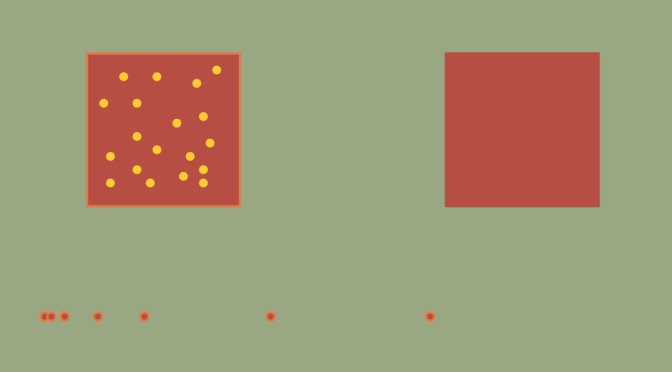Let’s play with the closure and the interior of sets.
To start the play, we consider a topological space \(E\) and denote for any subspace \(A \subset E\): \(\overline{A}\) the closure of \(A\) and \(\overset{\circ}{A}\) the interior of \(A\).
Warm up with the closure operator
For \(A,B\) subsets of \(E\), the following results hold: \(\overline{\overline{A}}=\overline{A}\), \(A \subset B \Rightarrow \overline{A} \subset \overline{B}\), \(\overline{A \cup B} = \overline{A} \cup \overline{B}\) and \(\overline{A \cap B} \subset \overline{A} \cap \overline{B}\).
Let’s prove it.
\(\overline{A}\) being closed, it is equal to its closure and \(\overline{\overline{A}}=\overline{A}\).
Suppose that \(A \subset B\). As \(B \subset \overline{B}\), we have \(A \subset \overline{B}\). Also, \(\overline{B}\) is closed so it contains \(\overline{A}\), which proves \(\overline{A} \subset \overline{B}\).
Let’s consider \(A,B \in E\) two subsets. As \(A \subset A \cup B\), we have \(\overline{A} \subset \overline{A \cup B}\) and similarly \(\overline{B} \subset \overline{A \cup B}\). Hence \(\overline{A} \cup \overline{B} \subset \overline{A \cup B}\). Conversely, \(A \cup B \subset \overline{A} \cup \overline{B}\) and \(\overline{A} \cup \overline{B}\) is closed. So \(\overline{A \cup B} \subset \overline{A} \cup \overline{B}\) and finally \(\overline{A \cup B} = \overline{A} \cup \overline{B}\).
Regarding the inclusion \(\overline{A \cap B} \subset \overline{A} \cap \overline{B}\), we notice that \(A \cap B \subset \overline{A} \cap \overline{B}\) and that \(\overline{A} \cap \overline{B}\) is closed to get the conclusion.
However, the implication \(\overline{A} \subset \overline{B} \Rightarrow A \subset B\) doesn’t hold. For a counterexample, consider the space \(E=\mathbb R\) equipped with the topology induced by the absolute value distance and take \(A=[0,1)\), \(B=(0,1]\). We have \(\overline{A}=\overline{B}=[0,1]\).
The equality \(\overline{A} \cap \overline{B} = \overline{A \cap B}\) doesn’t hold as well. For the proof, just consider \(A=[0,1)\) and \(B=(1,2]\).
Can \(\overline{A \cap B}\), \(\overline{A} \cap B\), \(A \cap \overline{B}\) and \(\overline{A} \cap \overline{B}\) be all different?
The answer is positive. We take again \(E=\mathbb R\) with \(A=[0,1) \cup [2,3)\) and \(B = [1,2)\).
Then \(\overline{A}=[0,1] \cup [2,3]\) and \(\overline{B}=[1,2]\), which gives:
\(\overline{A \cap B} = \emptyset\), \(\overline{A} \cap B = \{1\}\), \(A \cap \overline{B}=\{2\}\) and \(\overline{A} \cap \overline{B}=\{1,2\}\)
Can you find \(A \subset \mathbb R^2\) such that \(A, \overline{A}, \overset{\circ}{A}, \overset{\circ}{\overline{A}}, \overline{\overset{\circ}{A}}\) are all different?
Let’s build \(A\) by steps.
First, \(A\) cannot be closed nor open. For this, we pick-up the set consisting of the elements of a converging sequence whose values are distinct from the limit as: \[A_1=\{u_n=(\frac{1}{n},2) \ : \ n \in \mathbb N\}\] We also need to have \(\overset{\circ}{A} \neq \overset{\circ}{\overline{A}}\). This can be achieved by taking a dense subset of a closed subset of \(\mathbb R^2\), like \[A_2=[0,1] \cap \mathbb Q^2\] We have \(A_2= \emptyset\), \(\overline{A_2}=[0,1]^2\) and \(\overset{\circ}{\overline{A_2}}=(0,1)^2\).
Finally, \(\overset{\circ}{A}\) and \(\overline{\overset{\circ}{A}}\) have to be distinct, which can be achieved by taking the open square \[A_3=(3,4)^2\] for which \[A_3=(3,4)^2, \overset{\circ}{A_3}=A_3 \text{ and } \overline{A_3}=[3,4]^3\] Based on those subsets, we take \(A= A_1 \cup A_2 \cup A_3\). Then: \begin{align*} A &= A_1 \cup A_2 \cup A_3 \\
\overline{A} &= A_1 \cup \{(0,2)\} \cup [0,1]^2 \cup [3,4]^2\\
\overset{\circ}{A} &= (3,4)^2 \\
\overset{\circ}{\overline{A}} &= (0,1)^2 \cup (3,4)^2 \\
\overline{\overset{\circ}{A}} &= [3,4]^2
\end{align*}

